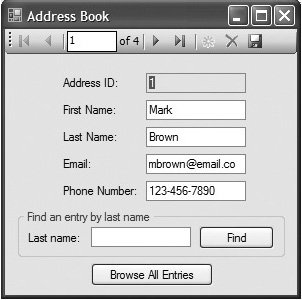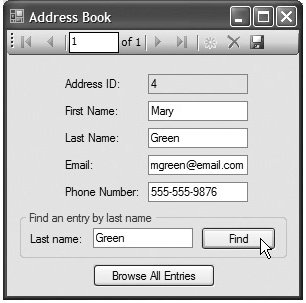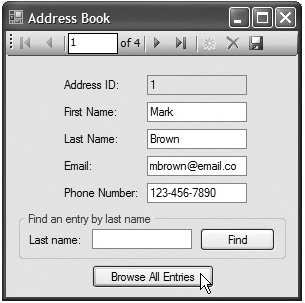Programming with ADO.NET: Address Book Case Study
Programming with ADO NET Address Book Case Study
Our next example implements a simple address book application that enables users to insert rows into, locate rows from and update the SQL Server database AddressBook.mdf (located in the chapter's examples directory on the CD that accompanies the book).
The AddressBook application (Fig. 20.44) provides a GUI through which users can execute SQL statements on the database. However, instead of displaying a database table in a DataGridView, this example presents data from a table one row at a time, using a set of TextBoxes that display the values of each of the row's columns. A BindingNavigator allows you to control which row of the table is currently in view at any given time. The BindingNavigator also allows you to add new rows, delete row, and save changes to the data in view. Note that lines 1734 in Fig. 20.44 are similar to the corresponding lines of code in the chapter's earlier examples. We discuss the application's additional functionality and the code in lines 3853 that supports it momentarily. We begin by showing you the steps to create this application.
Figure 20.44. AddressBook application that allows you to manipulate entries in an address book database.
1 // Fig. 20.44: AddressBook.cs
2 // Allows users to manipulate an address book.
3 using System;
4 using System.Windows.Forms;
5
6 namespace AddressBook
7 {
8 public partial class AddressBookForm : Form
9 {
10 public AddressBookForm()
11 {
12 InitializeComponent();
13 } // end AddressBookForm constructor
14
15 // Click event handler for the Save Button in the
16 // BindingNavigator saves the changes made to the data
17 private void addressesBindingNavigatorSaveItem_Click(
18 object sender, EventArgs e )
19 {
20 this.Validate();
21 this.addressesBindingSource.EndEdit();
22 this.addressesTableAdapter.Update(
23 this.addressBookDataSet.Addresses );
24 } // end method bindingNavigatorSaveItem_Click
25
26 // loads data into the addressBookDataSet.Addresses table
27 private void AddressBookForm_Load( object sender, EventArgs e )
28 {
29 // TODO: This line of code loads data into the
30 // 'addressBookDataSet.Addresses' table. You can move,
31 // or remove it, as needed.
32 this.addressesTableAdapter.Fill(
33 this.addressBookDataSet.Addresses );
34 } // end method AddressBookForm_Load
35
36 // loads data for the rows with the specified last name
37 // into the addressBookDataSet.Addresses table
38 private void findButton_Click( object sender, EventArgs e )
39 {
40 // fill the DataSet's DataTable with only rows
41 // containing the user-specified last name
42 addressesTableAdapter.FillByLastName(
43 addressBookDataSet.Addresses, findTextBox.Text );
44 } // end method findButton_Click
45 46 // reloads addressBookDataSet.Addresses with all rows 47 private void browseAllButton_Click( object sender, EventArgs e ) 48 { 49 // fill the DataSet's DataTable with all rows in the database 50 addressesTableAdapter.Fill( addressBookDataSet.Addresses ); 51 52 findTextBox.Text = ""; // clear Find TextBox 53 } // end method browseAllButton_Click 54 } // end class AddressBookForm 55 } // end namespace AddressBook
(a)
(b)
(c)
|
Step 1: Adding the Database to the Project
As in the preceding examples, you must begin by adding the database to the project. After adding the AddressBook.mdf as a data source, the Data Sources window will list AddressBookDataSet, which contains a table named Addresses.
Step 2: Indicating that the IDE Should Create a Set of Labels and TextBoxes to Display Each Row of Data
In the earlier sections, you dragged a node from the Data Sources window to the Form to create a DataGridView bound to the data source member represented by that node. The IDE allows you to specify the type of control(s) that it creates when you drag and drop a data source member onto a Form. In Design view, click the Addresses node in the Data Sources window (Fig. 20.45). Note that this node becomes a drop-down list when you select it. Click the down arrow to view the items in the list. The icon to the left of DataGridView will initially be highlighted in blue, because the default control to be bound to a table is a DataGridView (as you saw in the earlier examples). Select the Details option in the drop-down list to indicate that the IDE should create a set of LabelTextBox pairs for each column namecolumn value pair when you drag and drop the Addresses table onto the Form. (You will see what this looks like in Fig. 20.46.) The drop-down list contains suggestions for controls to display the table's data, but you can also choose the Customize... option to select other controls that are capable of being bound to a table's data.
Figure 20.45. Selecting the control(s) to be created when dragging and dropping a data source member onto the Form.

Figure 20.46. Displaying a table on a Form using a series of Labels and TextBoxes.
(This item is displayed on page 1035 in the print version)

Step 3: Dragging the Addresses Data Source Node to the Form
Drag the Addresses node from the Data Sources window to the Form (Fig. 20.46). The IDE creates a series of Labels and TextBoxes because you selected Details in the preceding step. As in the earlier examples, the IDE also creates a BindingNavigator and the other components in the component tray. The IDE sets the text of each Label based on the corresponding column name in the table in the database, and uses regular expressions to insert spaces into multiword column names to make the Labels more readable.
Step 4: Making the AddressID TextBox ReadOnly
The AddressID column of the Addresses table is an auto-incremented identity column, so users should not be allowed to edit the values in this column. Select the TextBox for the AddressID and set its ReadOnly property to TRue using the Properties window. Note that you may need to click in an empty part of the Form to deselect the other Labels and TextBoxes before selecting the AddressID TextBox.
Step 5: Running the Application
Run the application and experiment with the controls in the BindingNavigator at the top of the window. Like the previous examples, this example fills a DataSet object (specifically an AddressBookDataSet object) with all the rows of a database table (i.e., Addresses). However, only a single row of the DataSet appears at any given time. The CD- or DVD-like buttons of the BindingNavigator allow you to change the currently displayed row (i.e., change the values in each of the TextBoxes). The buttons to add a row, delete a row and save changes also perform their designated tasks. Adding a row clears the TextBoxes and makes a new auto-incremented ID (i.e., 5) appear in the TextBox to the right of Address ID. After entering some data, click the Save button to record the new row in the database. After closing and restarting the application, there should still be five rows. Delete the new row by clicking the appropriate button, then save the changes.
Step 6: Adding a Query to the AddressesTableAdapter
While the BindingNavigator allows you to browse the address book, it would be more convenient to be able to find a specific entry by last name. To add this functionality to the application, you must add a new query to the AddressesTableAdapter using the TableAdapter Query Configuration Wizard. Click the Edit DataSet with Designer icon ( ) in the Data Sources window. Select the box representing the AddressesTableAdapter. Right click the TableAdapter's name and select Add Query.... In the TableAdapter Query Configuration Wizard, keep the default option Use SQL Statements and click Next. On the next screen, keep the default option SELECT which returns rows and click Next. Rather than use the Query Builder to form your query (as we did in the preceding example), modify the query directly in the text box in the wizard. Append the clause "WHERE LastName = @lastName" to the end of the default query. Note that @lastName is a parameter that will be replaced by a value when the query is executed. Click Next, then enter FillByLastName and GetdataByLastName as the names for the two methods that the wizard will generate. The query contains a parameter, so each of these methods will take a parameter to set the value of @lastName in the query. You will see how to call the FillByLastName method and specify a value for @lastName shortly. Click Finish to complete the wizard and return to the Dataset Designer (Fig. 20.47). Note that the newly created Fill and Get methods appear under the AddressesTableAdapter and that parameter @lastName is listed to the right of the method names.
) in the Data Sources window. Select the box representing the AddressesTableAdapter. Right click the TableAdapter's name and select Add Query.... In the TableAdapter Query Configuration Wizard, keep the default option Use SQL Statements and click Next. On the next screen, keep the default option SELECT which returns rows and click Next. Rather than use the Query Builder to form your query (as we did in the preceding example), modify the query directly in the text box in the wizard. Append the clause "WHERE LastName = @lastName" to the end of the default query. Note that @lastName is a parameter that will be replaced by a value when the query is executed. Click Next, then enter FillByLastName and GetdataByLastName as the names for the two methods that the wizard will generate. The query contains a parameter, so each of these methods will take a parameter to set the value of @lastName in the query. You will see how to call the FillByLastName method and specify a value for @lastName shortly. Click Finish to complete the wizard and return to the Dataset Designer (Fig. 20.47). Note that the newly created Fill and Get methods appear under the AddressesTableAdapter and that parameter @lastName is listed to the right of the method names.
Figure 20.47. Dataset Designer for the AddressBookDataSet after adding a query to AddressesTableAdapter.
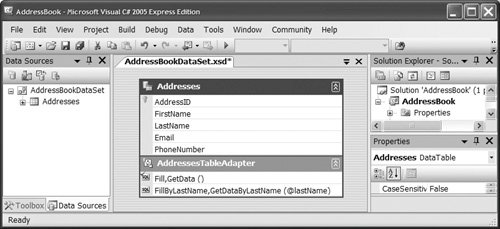
Step 7: Adding Controls to Allow Users to Specify a Last Name to Locate
Now that you have created a query to locate rows with a specific last name, add controls to allow users to enter a last name and execute this query. Go to Design view (Fig. 20.48) and add to the Form a Label named findLabel, a TextBox named findTextBox and a Button named findButton. Place these controls in a GroupBox named findGroupBox, then set its Text property to Find an entry by last name. Set the Text properties of the Label and Button as shown in Fig. 20.48.
Figure 20.48. Design view after adding controls to locate a last name in the address book.
(This item is displayed on page 1037 in the print version)
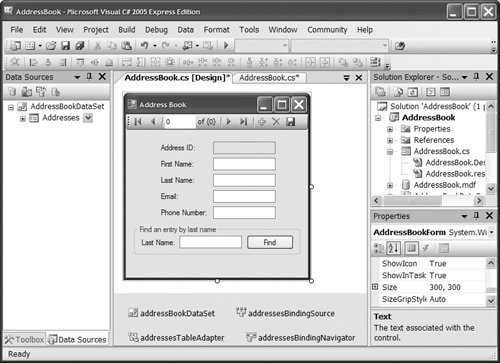
Step 8: Programming an Event Handler That Locates the User-Specified Last Name
Double click findButton to add a Click event handler for this Button. In the event handler, write the following lines of code (lines 4243 of Fig. 20.44):
addressesTableAdapter.FillByLastName( addressBookDataSet.Addresses, findTextBox.Text );
The FillByLastName method replaces the current data in addressBookDataSet.Addresses with data for only those rows with the last name entered in findTextBox. Note that when invoking FillByLastName, you must pass the DataTable to be filled, as well as an argument specifying the last name to find. This argument becomes the value of the @lastName parameter in the SELECT statement created in Step 6. Start the application to test the new functionality. Note that when you search for a specific entry (i.e., enter a last name and click Find), the BindingNavigator allows the user to browse only the rows containing the specified last name. This is because the data source bound to the Form's controls (i.e., addressBookDataSet.Addresses) has changed and now contains only a limited number of rows.
Step 9: Allowing the User to Return to Browsing All Rows in the Database
To allow users to return to browsing all the rows after searching for specific rows, add a Button named browseAllButton below the findGroupBox. Double click browseAllButton to add a Click event handler to the code. Set the Text property of browseAllButton to Browse All Entries in the Properties window. Add a line of code that calls addressesTableAdapter.Fill( addressBookDataSet.Addresses ) to refill the Addresses DataTable with all the rows from the table in the database (line 50 of Fig. 20.44). Also, add a line of code that clears the Text property of findTextBox (line 52). Start the application. Find a specific last name as in the previous step, then click the browseAllButton button to test the new functionality.
Data Binding in the AddressBook Application
Dragging and dropping the Addresses node from the Data Sources window onto AddressBookForm in this example caused the IDE to generate several components in the component tray. These serve the same purposes as those generated for the earlier examples that use the Books database. In this case, addressBookDataSet is an object of a strongly typed DataSet, AddressBookDataSet, whose structure mimics that of the AddressBook database. addressesBindingSource is a BindingSource object that refers to the Addresses table of the AddressBookDataSet. addressesTableAdapter encapsulates a SqlDataAdapter object configured with SqlCommand objects that execute SQL statements against the AddressBook database. Finally, addressesBindingNavigator is bound to the addressesBindingSource object, thus allowing you to indirectly manipulate the Addresses table of the AddressBookDataSet.
In each of the earlier examples using a DataGridView to display all the rows of a database table, the DataGridView's BindingSource property was set to the corresponding BindingSource object. In this example, you selected Details from the drop-down list for the Addresses table in the Data Sources window, so the values from a single row of the table appear on the Form in a set of TextBoxes. The IDE sets up the data binding in this example by binding each TextBox to a specific column of the Addresses DataTable in the AddressBookDataSet. To do this, the IDE sets the TextBox's DataBindings.Text property. You can view this property by clicking the plus sign next to (DataBindings) in the Properties window (Fig. 20.49). Clicking the drop-down list for this property allows you to choose a BindingSource object and a property (i.e., column) within the associated data source to bind to the TextBox.
Figure 20.49. Viewing the DataBindings.Text property of a TextBox in the Properties window.
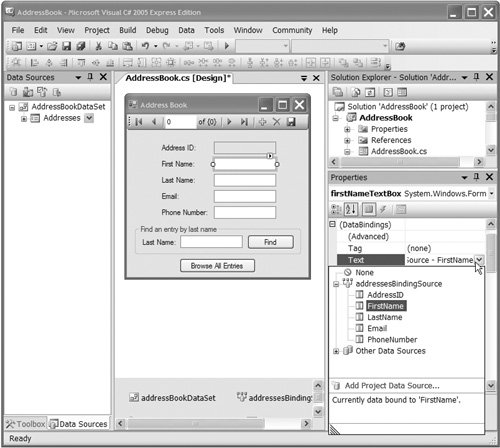
Consider the TextBox that displays the FirstName valuenamed firstNameTextBox by the IDE. This control's DataBindings.Text property is set to the FirstName property of the AddressesBindingSource (which refers to AddressBookDataSet.Addresses). Thus, firstNameTextBox always displays the value of the FirstName column in the currently selected row of addressBookDataSet.Addresses. Each IDE-created TextBox on the Form is configured in a similar manner. Browsing the address book with the AddressesBindingNavigator changes the current position in addressBookDataSet.Addresses and thus changes the values displayed in each TextBox. Regardless of changes to the contents of addressBookDataSet.Addresses, the TextBoxes remain bound to the same properties of the DataTable and always display the appropriate data. Note that the TextBoxes do not display any values if the cached version of Addresses is empty (i.e., if there are no rows in the DataTable because the query that filled the DataTable returned no rows).
Using a DataSet to Read and Write XML |
Preface
Index
Introduction to Computers, the Internet and Visual C#
- Introduction
- What Is a Computer?
- Computer Organization
- Early Operating Systems
- Personal Computing, Distributed Computing and Client/Server Computing
- Hardware Trends
- Microsofts Windows® Operating System
- Machine Languages, Assembly Languages and High-Level Languages
- C#
- C, C++, Java and Visual Basic
- Other High-Level Languages
- The Internet and the World Wide Web
- Extensible Markup Language (XML)
- Microsofts .NET
- The .NET Framework and the Common Language Runtime
- Test-Driving a C# Application
- Software Engineering Case Study: Introduction to Object Technology and the UML
- Wrap-Up
- Web Resources
- Summary
- Terminology
- Self-Review Exercises
- Exercises
Introduction to the Visual C# 2005 Express Edition IDE
- Introduction
- Overview of the Visual Studio 2005 IDE
- Menu Bar and Toolbar
- Navigating the Visual Studio 2005 IDE
- Using Help
- Using Visual Programming to Create a Simple Program Displaying Text and an Image
- Wrap-Up
- Web Resources
- Summary
- Terminology
- Self-Review Exercises
- Exercises
Introduction to C# Applications
- Introduction
- A Simple C# Application: Displaying a Line of Text
- Creating Your Simple Application in Visual C# Express
- Modifying Your Simple C# Application
- Formatting Text with Console.Write and Console.WriteLine
- Another C# Application: Adding Integers
- Memory Concepts
- Arithmetic
- Decision Making: Equality and Relational Operators
- (Optional) Software Engineering Case Study: Examining the ATM Requirements Document
- Wrap-Up
- Summary
- Terminology
- Self-Review Exercises
- Exercises
Introduction to Classes and Objects
- Introduction
- Classes, Objects, Methods, Properties and Instance Variables
- Declaring a Class with a Method and Instantiating an Object of a Class
- Declaring a Method with a Parameter
- Instance Variables and Properties
- UML Class Diagram with a Property
- Software Engineering with Properties and set and get Accessors
- Value Types vs. Reference Types
- Initializing Objects with Constructors
- Floating-Point Numbers and Type decimal
- (Optional) Software Engineering Case Study: Identifying the Classes in the ATM Requirements Document
- Wrap-Up
- Summary
- Terminology
- Self-Review Exercises
- Exercises
Control Statements: Part 1
- Introduction
- Algorithms
- Pseudocode
- Control Structures
- if Single-Selection Statement
- if...else Double-Selection Statement
- while Repetition Statement
- Formulating Algorithms: Counter-Controlled Repetition
- Formulating Algorithms: Sentinel-Controlled Repetition
- Formulating Algorithms: Nested Control Statements
- Compound Assignment Operators
- Increment and Decrement Operators
- Simple Types
- (Optional) Software Engineering Case Study: Identifying Class Attributes in the ATM System
- Wrap-Up
- Summary
- Terminology
- Self-Review Exercises
- Exercises
Control Statements: Part 2
- Introduction
- Essentials of Counter-Controlled Repetition
- for Repetition Statement
- Examples Using the for Statement
- do...while Repetition Statement
- switch Multiple-Selection Statement
- break and continue Statements
- Logical Operators
- Structured Programming Summary
- (Optional) Software Engineering Case Study: Identifying Objects States and Activities in the ATM System
- Wrap-Up
- Summary
- Terminology
- Self-Review Exercises
- Exercises
Methods: A Deeper Look
- Introduction
- Packaging Code in C#
- static Methods, static Variables and Class Math
- Declaring Methods with Multiple Parameters
- Notes on Declaring and Using Methods
- Method Call Stack and Activation Records
- Argument Promotion and Casting
- The Framework Class Library
- Case Study: Random-Number Generation
- Case Study: A Game of Chance (Introducing Enumerations)
- Scope of Declarations
- Method Overloading
- Recursion
- Passing Arguments: Pass-by-Value vs. Pass-by-Reference
- (Optional) Software Engineering Case Study: Identifying Class Operations in the ATM System
- Wrap-Up
- Summary
- Terminology
- Self-Review Exercises
- Exercises
Arrays
- Introduction
- Arrays
- Declaring and Creating Arrays
- Examples Using Arrays
- Case Study: Card Shuffling and Dealing Simulation
- foreach Statement
- Passing Arrays and Array Elements to Methods
- Passing Arrays by Value and by Reference
- Case Study: Class GradeBook Using an Array to Store Grades
- Multidimensional Arrays
- Case Study: Class GradeBook Using a Rectangular Array
- Variable-Length Argument Lists
- Using Command-Line Arguments
- (Optional) Software Engineering Case Study: Collaboration Among Objects in the ATM System
- Wrap-Up
- Summary
- Terminology
- Self-Review Exercises
- Exercises
- Special Section: Building Your Own Computer
Classes and Objects: A Deeper Look
- Introduction
- Time Class Case Study
- Controlling Access to Members
- Referring to the Current Objects Members with the this Reference
- Indexers
- Time Class Case Study: Overloaded Constructors
- Default and Parameterless Constructors
- Composition
- Garbage Collection and Destructors
- static Class Members
- readonly Instance Variables
- Software Reusability
- Data Abstraction and Encapsulation
- Time Class Case Study: Creating Class Libraries
- internal Access
- Class View and Object Browser
- (Optional) Software Engineering Case Study: Starting to Program the Classes of the ATM System
- Wrap-Up
- Summary
- Terminology
- Self-Review Exercises
- Exercises
Object-Oriented Programming: Inheritance
- Introduction
- Base Classes and Derived Classes
- protected Members
- Relationship between Base Classes and Derived Classes
- Constructors in Derived Classes
- Software Engineering with Inheritance
- Class object
- Wrap-Up
- Summary
- Terminology
- Self-Review Exercises
- Exercises
Polymorphism, Interfaces & Operator Overloading
- Introduction
- Polymorphism Examples
- Demonstrating Polymorphic Behavior
- Abstract Classes and Methods
- Case Study: Payroll System Using Polymorphism
- sealed Methods and Classes
- Case Study: Creating and Using Interfaces
- Operator Overloading
- (Optional) Software Engineering Case Study: Incorporating Inheritance and Polymorphism into the ATM System
- Wrap-Up
- Summary
- Terminology
- Self-Review Exercises
- Exercises
Exception Handling
- Introduction
- Exception Handling Overview
- Example: Divide by Zero Without Exception Handling
- Example: Handling DivideByZeroExceptions and FormatExceptions
- .NET Exception Hierarchy
- finally Block
- Exception Properties
- User-Defined Exception Classes
- Wrap-Up
- Summary
- Terminology
- Self-Review Exercises
- Exercises
Graphical User Interface Concepts: Part 1
- Introduction
- Windows Forms
- Event Handling
- Control Properties and Layout
- Labels, TextBoxes and Buttons
- GroupBoxes and Panels
- CheckBoxes and RadioButtons
- PictureBoxes
- ToolTips
- NumericUpDown Control
- Mouse-Event Handling
- Keyboard-Event Handling
- Wrap-Up
- Summary
- Terminology
- Self-Review Exercises
- Answers To Self-Review Exercises
- Exercises
Graphical User Interface Concepts: Part 2
- Introduction
- Menus
- MonthCalendar Control
- DateTimePicker Control
- LinkLabel Control
- ListBox Control
- CheckedListBox Control
- ComboBox Control
- TreeView Control
- ListView Control
- TabControl Control
- Multiple Document Interface (MDI) Windows
- Visual Inheritance
- User-Defined Controls
- Wrap-Up
- Summary
- Terminology
- Self-Review Exercises
- Exercises
Multithreading
- Introduction
- Thread States: Life Cycle of a Thread
- Thread Priorities and Thread Scheduling
- Creating and Executing Threads
- Thread Synchronization and Class Monitor
- Producer/Consumer Relationship without Thread Synchronization
- Producer/Consumer Relationship with Thread Synchronization
- Producer/Consumer Relationship: Circular Buffer
- Multithreading with GUIs
- Wrap-Up
- Summary
- Terminology
- Self-Review Exercises
- Exercises
Strings, Characters and Regular Expressions
- Introduction
- Fundamentals of Characters and Strings
- string Constructors
- string Indexer, Length Property and CopyTo Method
- Comparing strings
- Locating Characters and Substrings in strings
- Extracting Substrings from strings
- Concatenating strings
- Miscellaneous string Methods
- Class StringBuilder
- Length and Capacity Properties, EnsureCapacity Method and Indexer of Class StringBuilder
- Append and AppendFormat Methods of Class StringBuilder
- Insert, Remove and Replace Methods of Class StringBuilder
- Char Methods
- Card Shuffling and Dealing Simulation
- Regular Expressions and Class Regex
- Wrap-Up
- Summary
- Terminology
- Self-Review Exercises
- Exercises
Graphics and Multimedia
- Introduction
- Drawing Classes and the Coordinate System
- Graphics Contexts and Graphics Objects
- Color Control
- Font Control
- Drawing Lines, Rectangles and Ovals
- Drawing Arcs
- Drawing Polygons and Polylines
- Advanced Graphics Capabilities
- Introduction to Multimedia
- Loading, Displaying and Scaling Images
- Animating a Series of Images
- Windows Media Player
- Microsoft Agent
- Wrap-Up
- Summary
- Terminology
- Self-Review Exercises
- Exercises
Files and Streams
- Introduction
- Data Hierarchy
- Files and Streams
- Classes File and Directory
- Creating a Sequential-Access Text File
- Reading Data from a Sequential-Access Text File
- Serialization
- Creating a Sequential-Access File Using Object Serialization
- Reading and Deserializing Data from a Sequential-Access Text File
- Wrap-Up
- Summary
- Terminology
- Self-Review Exercises
- Exercises
Extensible Markup Language (XML)
- Introduction
- XML Basics
- Structuring Data
- XML Namespaces
- Document Type Definitions (DTDs)
- W3C XML Schema Documents
- (Optional) Extensible Stylesheet Language and XSL Transformations
- (Optional) Document Object Model (DOM)
- (Optional) Schema Validation with Class XmlReader
- (Optional) XSLT with Class XslCompiledTransform
- Wrap-Up
- Web Resources
- Summary
- Terminology
- Self-Review Exercises
- Exercises
Database, SQL and ADO.NET
- Introduction
- Relational Databases
- Relational Database Overview: Books Database
- SQL
- ADO.NET Object Model
- Programming with ADO.NET: Extracting Information from a Database
- Querying the Books Database
- Programming with ADO.NET: Address Book Case Study
- Using a DataSet to Read and Write XML
- Wrap-Up
- Web Resources
- Summary
- Terminology
- Self-Review Exercises
- Exercises
ASP.NET 2.0, Web Forms and Web Controls
- Introduction
- Simple HTTP Transactions
- Multitier Application Architecture
- Creating and Running a Simple Web-Form Example
- Web Controls
- Session Tracking
- Case Study: Connecting to a Database in ASP.NET
- Case Study: Secure Books Database Application
- Wrap-Up
- Web Resources
- Summary
- Terminology
- Self-Review Exercises
- Exercises
Web Services
- Introduction
- .NET Web Services Basics
- Simple Object Access Protocol (SOAP)
- Publishing and Consuming Web Services
- Session Tracking in Web Services
- Using Web Forms and Web Services
- User-Defined Types in Web Services
- Wrap-Up
- Web Resources
- Summary
- Terminology
- Self-Review Exercises
- Exercises
Networking: Streams-Based Sockets and Datagrams
- Introduction
- Connection-Oriented vs. Connectionless Communication
- Protocols for Transporting Data
- Establishing a Simple TCP Server (Using Stream Sockets)
- Establishing a Simple TCP Client (Using Stream Sockets)
- Client/Server Interaction with Stream-Socket Connections
- Connectionless Client/Server Interaction with Datagrams
- Client/Server Tic-Tac-Toe Using a Multithreaded Server
- WebBrowser Control
- .NET Remoting
- Wrap-Up
- Summary
- Terminology
- Self-Review Exercises
- Exercises
Searching and Sorting
- Introduction
- Searching Algorithms
- Sorting Algorithms
- Wrap-Up
- Summary
- Terminology
- Self-Review Exercises
- Exercises
Data Structures
- Introduction
- Simple-Type structs, Boxing and Unboxing
- Self-Referential Classes
- Linked Lists
- Stacks
- Queues
- Trees
- Wrap-Up
- Summary
- Terminology
- Self-Review Exercises
- Exercises
Generics
- Introduction
- Motivation for Generic Methods
- Generic Method Implementation
- Type Constraints
- Overloading Generic Methods
- Generic Classes
- Notes on Generics and Inheritance
- Wrap-Up
- Summary
- Terminology
- Self-Review Exercises
- Exercises
Collections
- Introduction
- Collections Overview
- Class Array and Enumerators
- Non-Generic Collections
- Generic Collections
- Synchronized Collections
- Wrap-Up
- Summary
- Terminology
- Self-Review Exercises
- Exercises
Appendix A. Operator Precedence Chart
Appendix B. Number Systems
- B.1. Introduction
- B.2. Abbreviating Binary Numbers as Octal and Hexadecimal Numbers
- B.3. Converting Octal and Hexadecimal Numbers to Binary Numbers
- B.4. Converting from Binary, Octal or Hexadecimal to Decimal
- B.5. Converting from Decimal to Binary, Octal or Hexadecimal
- B.6. Negative Binary Numbers: Twos Complement Notation
- Summary
- Terminology
- Self-Review Exercises
- Exercises
Appendix C. Using the Visual Studio 2005 Debugger
- C.1. Introduction
- C.2. Breakpoints and the Continue Command
- C.3. The Locals and Watch Windows
- C.4. Controlling Execution Using the Step Into, Step Over, Step Out and Continue Commands
- C.5. Other Features
- C.6. Wrap-Up
- Summary
- Terminology
- Self-Review Exercises
Appendix D. ASCII Character Set
Appendix E. Unicode®
- E.1. Introduction
- E.2. Unicode Transformation Formats
- E.3. Characters and Glyphs
- E.4. Advantages/Disadvantages of Unicode
- E.5. Using Unicode
- E.6. Character Ranges
- Summary
- Terminology
- Self-Review Exercises
- Answers to Self-Review exercises
- Exercises
Appendix F. Introduction to XHTML: Part 1
- F.1. Introduction
- F.2. Editing XHTML
- F.3. First XHTML Example
- F.4. W3C XHTML Validation Service
- F.5. Headers
- F.6. Linking
- F.7. Images
- F.8. Special Characters and More Line Breaks
- F.9. Unordered Lists
- F.10. Nested and Ordered Lists
- F.11. Web Resources
Appendix G. Introduction to XHTML: Part 2
- G.1. Introduction
- G.2. Basic XHTML Tables
- G.3. Intermediate XHTML Tables and Formatting
- G.4. Basic XHTML Forms
- G.5. More Complex XHTML Forms
- G.6. Internal Linking
- G.7. Creating and Using Image Maps
- G.8. meta Elements
- G.9. frameset Element
- G.10. Nested framesets
- G.11. Web Resources
Appendix H. HTML/XHTML Special Characters
Appendix I. HTML/XHTML Colors
Appendix J. ATM Case Study Code
- Appendix J. ATM Case Study Code
- J.1. ATM Case Study Implementation
- J.2. Class ATM
- J.3. Class Screen
- J.4. Class Keypad
- J.5. Class CashDispenser
- J.6. Class DepositSlot
- J.7. Class Account
- J.8. Class BankDatabase
- J.9. Class Transaction
- J.10. Class BalanceInquiry
- J.11. Class Withdrawal
- J.12. Class Deposit
- J.13. Class ATMCaseStudy
- J.14. Wrap-Up
Appendix K. UML 2: Additional Diagram Types
Appendix L. Simple Types
Index
EAN: 2147483647
Pages: 600
